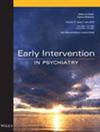Translation and Adaptation of the Comprehensive Assessment of At-Risk Mental State (CAARMS) in Urdu and Establishing Its Psychometric Properties
Abstract
Objectives
The term ‘At Risk Mental State’ (ARMS) has been used since the mid-1990s to describe a state prospectively in which a young person has a heightened risk of developing a psychotic disorder. Comprehensive Assessment of At-Risk Mental State (CAARMS) is an interview schedule that can be utilised to assess ARMS reliably and accurately. The present multistage study envisioned translating and adapting CAARMS into Urdu and establishing its psychometric properties so that it can effectively serve the purpose of recognising and treating the prodromal phase of first-episode psychosis for the Urdu-speaking population, especially in Pakistan.
Method
The translation was done by employing seven steps outlined by Sousa and Rojjanasrirat (2011). The translated and adapted tool was administered on a sample of n = 87 (first episode psychosis [FEP] = 30 UHR + [ARMS] = 27; UHR – [normal] = 30) which was obtained from psychiatry departments of different hospitals and the community. Inter-rater reliability and concurrent validity were established by running Pearson Correlation, while construct validity was established by employing the Kruskal–Wallis H test.
Results
The results showed that the CAARMS-Urdu had a content validity index (I-CVI) of 1; inter-rater reliability of 0.99; Cronbach's alpha coefficient of 0.97; and good construct and concurrent validity.
Conclusion
The CAARMS-U displayed excellent reliability and validity. In the future, CAARMS-U could be used to assess early psychosis and the efficient diagnosis of ARMS individuals in Urdu-speaking communities.

 求助内容:
求助内容: 应助结果提醒方式:
应助结果提醒方式:


